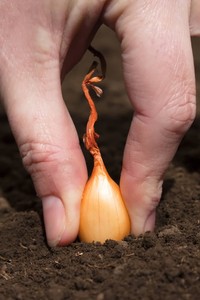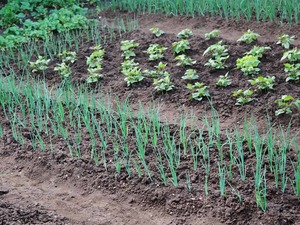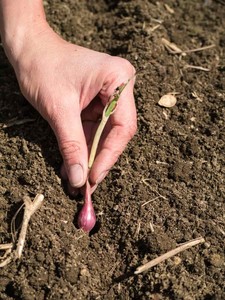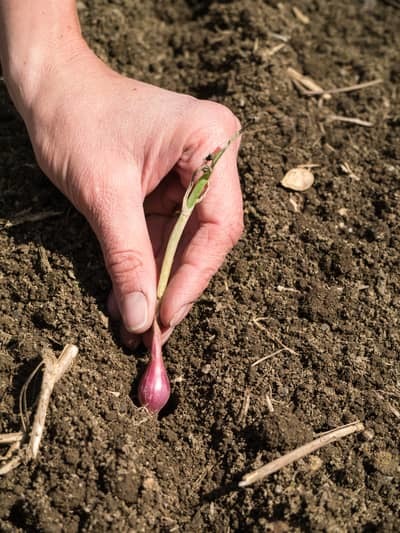If you’re figuring out what kinds of vegetables you want to grow in your greenhouse, onions are a great addition.
Planting onion sets (instead of onion seeds or onion transplants) is the easiest, fastest way to grow onions. Dig some very shallow holes for your onions, not more than 1 inch below the ground. The holes should be about twice as wide as your bulb, 4 – 5 inches apart. Water liberally.
You can buy onion sets at gardening stores and plant them in small areas in your garden or greenhouse—they need very little space to get started. You’ll just need to make sure they’re getting enough light, nutrients, and water, and you’re on your way to harvesting some beautiful onions.

What are onion sets?
Generally, there are 3 ways to grow onions:
- from seeds,
- sets,
- or transplants.
If you grow onions from sets, this essentially means you’re planting half-bulbs.
You can look at it as the “in between” stage—sets involve a partially grown bulb, so they are halfway through their growing cycle.
The seed has grown into a bulb, but that bulb hasn’t yet flowered and become a full onion.
You can buy onion sets at any gardening store in red, yellow, and white varieties.
Both green onions and larger onions can be grown from sets—they’ll just have different growing periods (more on that later!).
See the growth stages of onions.
Benefits of planting onion sets
Like I said above, you can choose to plant onions from seeds, sets, or transplants. I’ve chosen to focus on sets in this post because of the numerous benefits of growing this way.
- Level of difficulty: Onion sets are considered the easiest way to grow onions.
- Success rate: Gardeners have found that they are most successful when using onionsets.
- Time to harvest: With onion sets, you only need one growing season to produceonions. If you use seeds, your onions will take two seasons (one for the seedsto bulb and another for the bulbs to flower).
- Space needed: Onions have shallow root systems so they don’t need a lot of depthin the soil, and they also don’t need a lot of space to grow! You can fit onionsets into awkward spaces in your greenhouse or plant them between other plantsthat are already growing.
- Weather considerations:When you grow with seeds, you have to take precautions against frost damage.Since sets only need 1 season to grow, this isn’t an issue and onion sets cansurvive inclement weather.
Beware of this when buying onion sets
The main drawback of sets is that because they have already begun their growing process, they are at risk of “bolting,” or flowering prematurely.
You should be okay as long as the store from which you buy your sets has stored them properly and you store them properly after buying.
More on that below!
Oh, and this is interesting: find out if onions are vegetables.
Buying Your Onion Sets
When you go to a gardening or home improvement store, you’ll see that onion sets come in different varieties.
Typically stores sell red, white, and yellow sets but don’t specify size or more specific varieties.
Picking out a variety of onion sets is all about preference.
What kinds of onions do you like?
What will you be doing with your onions?
any gardeners will grow multiple sets of onions so that they can have different varieties, so you may pick out a red set and a yellow set, for example.
After you pick out your sets, you’ll find different sizes of dormant (meaning the bulbs haven’t begun to flower yet) sets in your bag or box.
If you aren’t ready to plant yet, you’ll want to store the onions in a cool, dry place.
You should also check your onions regularly for signs of rotting, and remove any rotting onions as quickly as possible to keep the rotting from spreading to the other onions.
When you’re ready to begin planting, you’ll want to sort the sets by size.
Sets that are already larger will do better as green onions (you can grow green onions from white, yellow, or red sets).
Smaller sets are easier to plant and keep in the ground for longer, so these can be your larger onion plants.

Getting Started: When to Plant Onion Sets and What You’ll Need
Light
With any plant, light is a good place to start.
We know that every plant needs light to survive but the amounts will vary.
Onions are full sun plants, so even if you’re planting in a greenhouse, spring is the best time to plant.
This way, the onions can take advantage of the summer sun and you don’t have to spend extra on artificial light.
If you’d rather plant at a different time of year, that’s fine too!
Onion sets are hardy and can survive cooler temperatures.
You’ll just need to make sure your plants are getting enough light if you plant during a season that doesn’t offer as much natural light.
Also, different onion sets will need different amounts of light, and certain varieties will grow best in certain regions.
Onions are usually categorized as long day or short day, where long day varieties grow best with more daylight hours and short day grow best with less.
Most likely, your gardening store will carry only the sets that will grow well where you live, but it doesn’t hurt to ask an employee about this just to make sure.
See how much light onions need (and whether they’ll grow in shade).
Nutrients
Onions also need a lot of nutrients in order to thrive.
They rely particularly on nitrogen, so you’ll want to make sure you can measure the pH of your soil regularly and add nutrients if needed.
Before you plant, you’ll want to add compost or manure to your soil to provide those nutrients.
Then when you’re ready to plant, you can mix in a nitrogen fertilizer.
Your soil should be loose rather than compact—onions thrive in looser soil because it helps them access those nutrients and water more efficiently.
Water
Speaking of water, onions need a lot of it!
They’ll need about an inch of water per week, and the best time to water will always be the morning if that’s feasible for you.
If you have an automatic watering system, setting it for the morning will be best for your onions (and all of your summer plants!).
The soil should always be moist, so you can feel it and add more water if needed.
That being said, just as with your other plants, you risk drowning and molding if you overwater.
It’s probably better to be conservative and add water if you feel the soil quickly drying.
Planting your onion sets
Your soil is full of nutrients, you’ve picked out a spot full of light, and you’ve got a watering system or plan in place. It’s time to plant your onions!
Onions have shallow root systems, and this means that in order to get their nutrients and water, they need to be buried pretty close to the surface.
You can go ahead and dig some very shallow holes for your onions, not more than an inch below the ground.
The holes should be about twice as wide as your bulb, maybe slightly wider just to be safe.
The holes can be four to five inches apart because onions don’t need much space to grow.
If you’re planting multiple rows of onions, leave about a foot in between rows.
If your soil is dry when you plant the onions, make sure you water right away as those onions will need moisture when they move into their new homes underground.
The growing period for your onions will be different depending on size and type.
Green onions grow quickly and should be ready for harvesting about a month after planting.
You will pull the entire plant out of the ground for green onions and your onion set bulb won’t have expanded by this time.
Larger onions will take a couple of months to grow fully.
When you buy your onion sets, you’ll be able to choose a size, and the size will determine the onion’s growing period.
Larger onions will take longer than smaller ones, so this is really up to you in terms of what types and sizes of onions you prefer.

Related Questions
How many onions grow from one bulb?
One onion will grow from one bulb. If you buy onion sets, though, you’ll get multiple sets in a bag.
Most stores display their onion sets in mesh bags, so you should be able to see how many sets you’ll have per bag that you buy.
What are other ways to grow onions?
You can also grow onions from seeds or transplants, with seeds and sets being the most common and transplants less so.
There are benefits and drawbacks to each and it is really up to you in terms of what you prefer and the kind of space and time that you have.
Do onions come back every year?
This is a complicated question, and the easiest answer is that some do and some don’t.
If you’re growing from sets, you’ll want to plant new sets each year. If you decide to grow from seeds, your onion plants will produce more seeds and may then come back every year. Keep in mind, though, that “every year” for seeds is really every other year, as they need a year to form a bulb and another year for the bulb to grow into an onion.


